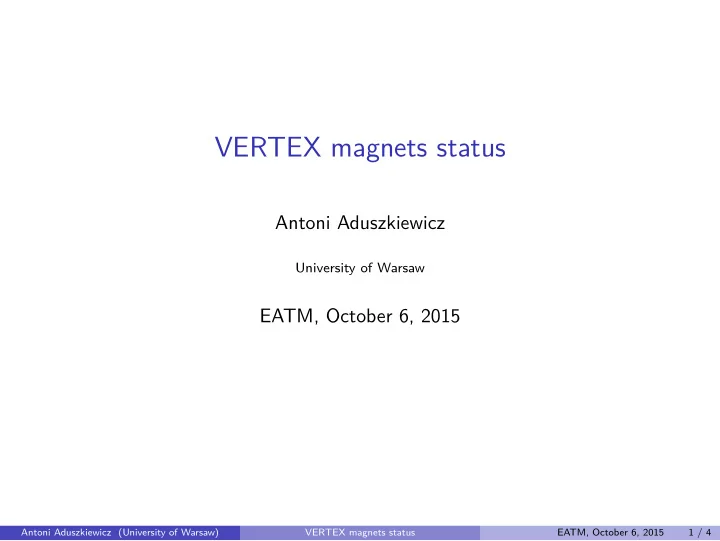

VERTEX magnets status Antoni Aduszkiewicz University of Warsaw EATM, October 6, 2015 Antoni Aduszkiewicz (University of Warsaw) VERTEX magnets status EATM, October 6, 2015 1 / 4
VERTEX-1 superconducting magnet fault The first week VERTEX-1 was turned on 4 times. 3 times it discharged (automatic emergency switch off): ◮ Sep 09: The magnet was ramped up to 5000A (full field) for a test, and half hour later ramped down. At about 2500A it underwent fast discharge. ◮ Sep 12: The magnet was running for 10h at 5000A, when we observed the helium level decreasing. We decided to switch it off, successfully. ◮ Sep 12: The magnet discharged from 5000A after 6 hours of operation. It was preceded by a decrease in the helium flow (“debit pompes”) to 70%. ◮ Sep 14: The magnet discharged from 5000A after 8 hours of operation. Similar decrease in helium flow was observed. Only afterwards cryo realised there is a problem in their system. With help of Alexey Dudarev they discovered that during the first event during ramping down already at around 3000A the helium flow to the electric leads was stopped. Later examination revealed that this caused damage and non-zero resistance near one of the current leads, and was a probable cause of the two later discharges. The probable cause of the incident is coincident abnormal helium hardware operation together with incorrect software logic controlling helium flow, not realised until now Antoni Aduszkiewicz (University of Warsaw) VERTEX magnets status EATM, October 6, 2015 2 / 4
VERTEX-1 status The magnet is being warmed up without breaking vacuum, by injecting cold gaseous helium and gradually increasing its temperature in a controlled way. Once the magnet is warm it will be examined to see which part exactly is damaged and how it can be repaired. Antoni Aduszkiewicz (University of Warsaw) VERTEX magnets status EATM, October 6, 2015 3 / 4
Quench protection system and plans The incident revealed shortcomings of the existing quench protection system: ◮ Although there are more than 30 points to measure voltage drops in the magnet, only a very simple logic is used. In particular the system will not detect a resistance developing symmetrically in the upper and the lower coil ◮ The voltage threshold is constant thus the protection level is much decreased when operating below the full magnetic field (which we do a lot in NA61) ◮ Temperature of the superconductor is not measured Alexey Dudarev recommends installation of better quench protection system for VERTEX-1 and VERTEX-2 PH-DT prepared a project of a new quench protection system. The final system should be operational at the beginning of March 2016. VERTEX-2 will not be used before the new quench protection system is installed. The current proton NA61/SHINE run will be finished 2 weeks earlier than planned, on October 21. The Pb run in November is not cancelled! Antoni Aduszkiewicz (University of Warsaw) VERTEX magnets status EATM, October 6, 2015 4 / 4
Recommend
More recommend